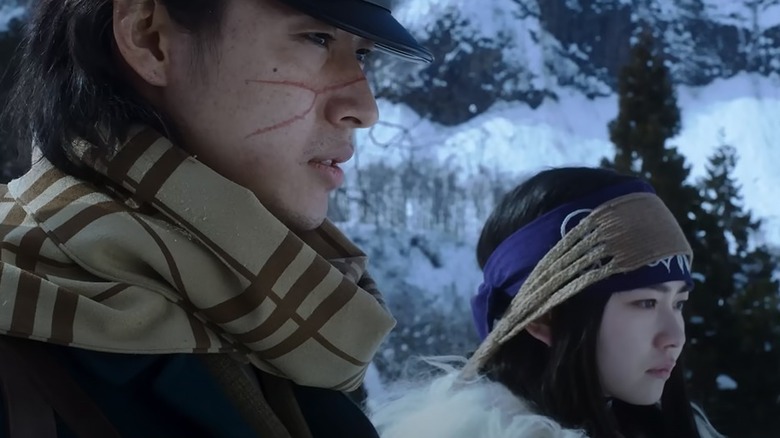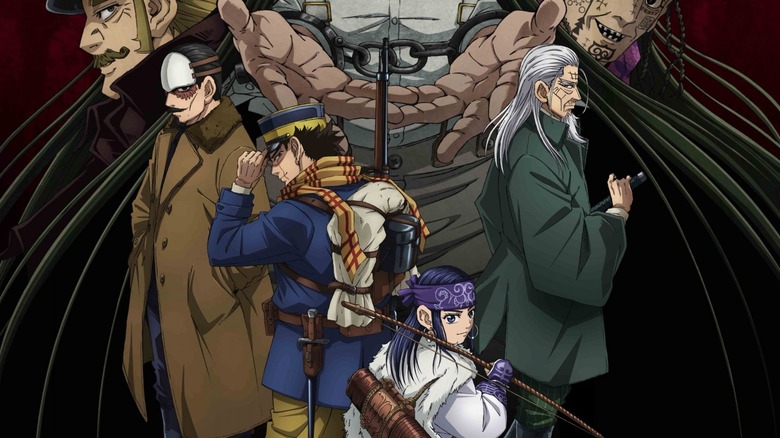Netflix Viewers Zeroed In On A New Live-Action Anime Adaptation
Anime is more than just a niche in the United States now and Hollywood is taking notice — Netflix especially. The streamer has both produced English-language anime movie/TV adaptations in-house ("One Piece," "Cowboy Bebop") and imported shows made in Japan for international distribution (such as the live-action "Fullmetal Alchemist" trilogy). One can only wonder which anime Netflix will see fit to adapt next — and whether fans should see that as a promise or a threat.
In the meantime, one of Netflix's most recent imports won't convince it to slow down on live-action anime. 2024's "Golden Kamuy," which premiered in Japanese theaters this past January, was added to Netflix on May 19, 2024. The film is an adaptation of a manga by Satoru Noda, which was previously adapted as an anime in 2018. The "Golden Kamuy" manga is complete (it ran for 314 chapters from 2015 to 2022), while the anime still has a fifth and final season on the horizon adapting the manga's last chapters. The live-action rendition gives fans yet another version of this story and they're paying attention.
Variety found that during the week of May 24-30 2024, "Golden Kamuy" was the ninth most watched streaming original movie across all major platforms. (Its "streaming original" status is a technicality of American release, but still.) It was the seventh Netflix film listed on the chart, with Netflix subscribers having reportedly watched a collective 75.9 million minutes' worth of the movie.
So, is "Golden Kamuy" worth checking out — especially when the original manga and anime are right there?
Golden Kamuy is about gold... and murder
"Kamuy" is a Japanese word meaning "spirit." As for "Golden," that refers to the story's MacGuffin.
"Golden Kamuy" is set in 1900s Hokkaido (a northern, rural island of Japan). The lead, Saichi Sugimoto, is a veteran of the Russo-Japanese war. He is known as "Immortal Sugimoto" because, during the climactic battle of Hill 203, he healed from wounds that should've been fatal. His best friend Toraji was not so lucky and asked Sugimoto to look after his widow.
In 1907, Sugimoto is gold panning a river in Hokkaido with little luck until a fellow prospector tells him a tall tale. The story goes that Ainu (the indigenous people of Japan) miners discovered an enormous stockpile of gold — so enormous that one of them slaughtered his comrades to have it all. This one miner was imprisoned by the Japanese government but refused to tell where he'd hidden the gold. Instead, he tattooed a map to its location across the torsos of 24 of his fellow convicts. These tattooed prisoners escaped and should one copy (or skin) all their tattoos, they can find the Ainu gold.
The story is crazy enough to be true. Soon, Sugimoto partners up with Asirpa, a teenage Ainu girl whose father was one of the murdered miners; she intends to avenge him and use the gold to help her people. Unfortunately, the pair aren't the only ones hunting for it. The scarred Lieutenant Tsurumi, leader of the Japanese military's 7th division, has his men scouring Hokkaido for any clues to the gold (he intends to finance a coup and make the island into his own fiefdom). The 24 convicts themselves want the gold too, chief among them Hijikata Toshizō. Once a Samurai in pre-Meiji Japan, Hijikata is still loyal to the long-deposed shogunate and wants the gold to build a new nation in that feudal mold.
Golden Kamuy is a Japanese Western
"Golden Kamuy" is ultimately a treasure hunt story, a la "Indiana Jones" or "National Treasure." Multiple factions of characters in a race against time and each other to find clues to their ultimate prize? Stories like that are catnip to me.
While the premise of "Golden Kamuy" is anime-newbie friendly, from its genre to its grounding in real history, it's also intertwined with Japanese culture. (The anime is one where I'm always sure to watch with the original Japanese audio, not just for the performances but because the characters are diegetically speaking Japanese.) A big theme in the story is the split between Japanese culture and Ainu traditions; Asirpa simultaneously introduces Sugimoto and the audience to her people's customs. That's why this action-chase series has lots of scenes of people sitting around campfires cooking and eating. In "Golden Kamuy," food is the cement of cultural bridges.
Will themes of the story be lost on American audiences? Perhaps, but others will speak to them because "Golden Kamuy" takes after the quintessential American film genre: the Western. It's basically a Japanese take on "The Good, The Bad, and the Ugly," Sergio Leone and Clint Eastwood's titanic Spaghetti Western about three cowboys chasing gold in 1862 New Mexico. "Golden Kamuy" too has the good (Sugimoto and Asirpa), the bad (Hijikata), and the ugly (Tsurumi). Leone and Eastwood kicked off their Western reign by aping Akira Kurosawa's "Yojimbo" for 1964's "A Fistful of Dollars," so now that comes full-circle.
Like many Westerns, "Golden Kamuy" is set on a harsh frontier (though Hokkaido is covered in snow, not scorching heat like the American west) with a war veteran protagonist living on society's fringes. The role of the Ainu likewise feels analogous to the importance of Native-Americans in Western mythology. Like how revisionist Westerns these days try to mend how old movies villainized indigenous people, "Golden Kamuy" treats its Ainu characters with more respect than the Japanese have historically bestowed on them.
How well does Golden Kamuy make the leap to live-action?
Directed by Shigeaki Kubo, 2024's "Golden Kamuy" is a competent adaptation that succeeds at bringing the story out of its native hand-drawn mediums. It helps that the setting and character designs (mostly a lot of burly Japanese men in blue military uniforms) look natural in live-action too. The film has plentiful landscape shots of the icy beautiful Hokkaido tundra, rivaling the beauty of Noda's drawings. The opening scene, showing Sugimoto at the battle of Hill 203, feels right out of a gritty war movie; it's carved in the same mold as the "Saving Private Ryan" opening but set among trenches, not Omaha beach.
If there's one part of the story the film struggles with, it's the comedy. "Golden Kamuy" has a lot of slapstick, more than you'd expect from a historical thriller. Shiraishi, one of the 24 tattooed convicts and a cowardly escape artist (played by Yuma Yamoto), screams most of his lines and moves like no normal person does. Even this live-action version doesn't make him feel like not a cartoon character. On the other hand, actor Hiroshi Tamaki succeeds in capturing the conflicting traits of Tsurumi: creepy yet charismatic, theatrical yet truly scary.
I can picture a movie adaptation of "Golden Kamuy" that heavily streamlines the story and turns the gold hunt into a two hour adventure, but that's not what this movie is. It adapts the first two volumes or so, leaving much of the story ahead of it. As such, it feels like a feature-length series pilot — which it literally is, for the movie's story will continue as a TV series (no word on release outside Japan yet).
"Golden Kamuy" is a fine adaptation, but hard to describe as the definitive version of this story. If you do want to watch it, though, it's now streaming on Netflix.



